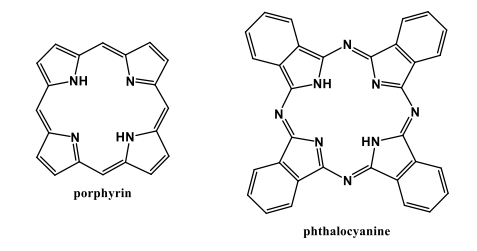The creation of new materials with tunable properties and functionality to solve specific practical problems is a key area of modern chemistry. Development and research of promising functional materials with properties of interest to us for various industrial fields, such as electronics, medicine, energy industry and others. These materials may have improved mechanical, electrical, thermal or chemical properties, which opens up new opportunities for the creation of more advanced products and technologies.
Porphyrins and phthalocyanines (pic.1) are classes of organic compounds that have unique properties that make them potentially valuable components for new materials.

Picture 1. Structure of porphyrin and phthalocyanine macrocycles.
Porphyrins are key components of chlorophyll and heme, indicating their important biological function. However, in addition to this, porphyrins have interesting optical and electronic properties. Their ability to form complexes with various metals opens up the potential for the use of porphyrins as catalysts and optical materials. Due to their molecular structure, porphyrins can also serve as important components for electronic devices.
Phthalocyanines have high oxidation resistance and chemical stability, making them attractive for use in a variety of engineering applications. Their ability to form complexes with metals opens up new opportunities for the creation of catalysts and materials with controlled optical properties. Phthalocyanines also show potential in the field of electronic devices due to their electronic conductivity.
It is already known that metal phthalocyanines are used for the production of dyes and pigments, photochromic materials and therapeutic drugs. To date, there are a number of studies aimed at the effective use of phthalocyanine complexes as catalysts for photoactive lithium-oxygen batteries [1], dopants for the creation of organic solar cells [2], and molecular additives, which modify the ionic solvate structures and transport properties of electrolytes to improve the Li+ transfer number [3], phthalocyanines are also expected to be promising catalysts in the field of hydrogen production [4]. Modified phthalocyanine complexes represent a versatile, promising class of components for the development of innovative materials with controlled optical and photochemical properties of a new generation with a wide range of potential applications. Functionalization of the periphery of the macrocycle by introducing peripheral and non-peripheral substituents and variation of the complexing metal are the main methods for controlling and controlling the properties of the resulting compounds.
As is known, porphyrins can be used as a source of analytical signal, which can help solve problems associated with the detection of various ions in solutions, which has recently been actively studied with the aim of creating ion-sensitive materials. The relevance of developing research in the field of creating materials for highly sensitive optical sensors that make it possible to determine the concentration of various metal ions in solutions is determined by the need to increase their sensitivity and selectivity [5-7].
Both of these classes of compounds have the potential to create new materials with unique properties, such as molecular distribution, optical activity, electronic conductivity, and others. Their applications could be key to the development of advanced materials for electronics, photonics, catalysis and other fields.
Список литературы
- Kichambare P. Phthalocyanine-based bifunctional soluble hybrid catalyst for rechargeable lithium-oxygen batteries //Chemical Physics Letters. – 2024. – V. 841. – P. 141179
- Lu C., Yu Z., Cao J. Advancement in Porphyrin/Phthalocyanine Compounds-based Perovskite Solar Cells //Chinese Journal of Structural Chemistry. – 2024. – P. 100240
- Li X. Dilithium phthalocyanine as electrolyte additive for the regulation of ion solvation and transport towards dendrite-free Li metal anodes //Chemical Engineering Journal. – 2022. – V. 450. – P. 138112
- Keshipour S., Asghari A. A review on hydrogen generation by phthalocyanines //International Journal of Hydrogen Energy. – 2022. – V. 47. – №. 26. – P. 12865-12881
- Biesaga M., Pyrzyńska K., Trojanowicz M. Porphyrins in analytical chemistry. A review //Talanta. – 2000. – V. 51. – №. 2. – P. 209-224
- Vlascici D. Free base porphyrins as ionophores for heavy metal sensors //Sensors. – 2008. – V. 8. – №. 8. – P. 4995-5004
- Cano-Raya C., Fernández-Ramos M. D., Capitán-Vallvey L. F. Fluorescence resonance energy transfer disposable sensor for copper (II) //Analytica chimica acta. – 2006. – V. 555. – №. 2. – P. 299-307



